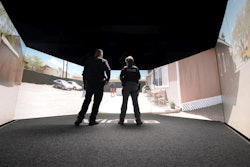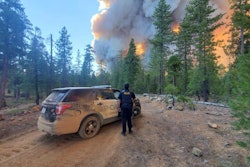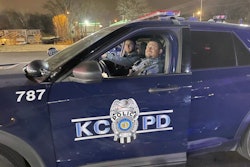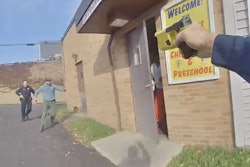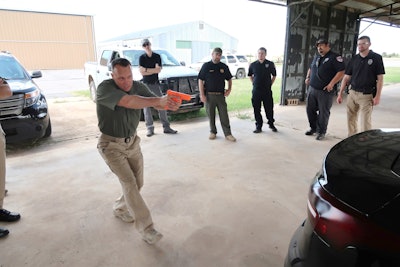 Mike Willis, of the United States Deputy Sheriff's Association, conducts a training on felony and high-risk traffic stops.PHOTO: United States Deputy Sheriff's Association
Mike Willis, of the United States Deputy Sheriff's Association, conducts a training on felony and high-risk traffic stops.PHOTO: United States Deputy Sheriff's Association
Officer safety must be a priority when it comes to felony and high-risk traffic stops. Cops should not immediately rush forward, but instead should slow down enough to focus on safety while controlling and then resolving the situation.
Mike Willis, national training and programs director for the United States Deputy Sheriff's Association (USDSA), travels the country and teaches several courses, including Felony and High-Risk Vehicle Stop Training for Officer Survival. He started his career as a police officer and then moved to a sheriff’s office. Along his career path in law enforcement, Willis has worked as a defensive tactics trainer, SWAT assistant team leader, and point man for a countywide SWAT team.
“It's a nationwide epidemic in law enforcement, cops at the end of pursuits or situations running up to vehicles. It's the worst thing we could be doing. It's getting people killed,” he says. “This has got to stop. This mindset has got to stop. Let's stay back behind cover and do it safer.”
Willis points out officers should slow down, take a deep breath, and let their adrenaline settle down. He says taking those simple steps can help officers make better decisions. That in turn helps keep officers safer, but also helps in other ways as well.
“We live in this world where cameras are everywhere, and people have their cell phones out. But if we do everything right, we are courteous but firm on our commands, and we treat people right — that doesn't mean people have to be all thrown down on the ground or guns pouring out and all these different things — it’s going to avoid us these lawsuits, these problems, these bad optics we have,” Willis explains.
Training to handle high-risk traffic stops can also build officers’ abilities to manage what appear to be routine traffic stops that suddenly shift in a more dangerous direction.
“You know, they always say ‘There's no such thing as a routine traffic stop.’ There's so much truth to that, because officers, they might be thinking ‘I'm stopping someone for speeding,’ but the reason they're speeding is they just robbed a convenience store and they think you're stopping them because of that,” says Willis. “Unfortunately, law enforcement doesn't know what they're getting into often. We’re reactionary, that’s what we are and that's why we can't necessarily go up there guns drawn. We don't need to be doing that.”
Willis recalls a story from his state, Oklahoma, where a state trooper was shot during what he thought was a traffic stop of a speeding motorist. The trooper approached the vehicle and was shot as he walked up. He did not know the occupants were the ones who had just robbed a bank and then switched cars.
“He had no idea and he walked up on the car, and they shot him because he they think they're he's coming up there to get him for the bank robbery,” Willis explains.
In his training role at the United States Deputy Sheriff’s Association, Willis packs a lot of information into Felony and High-Risk Vehicle Stop Training for Officer Survival, a one-day course he teaches at departments across the country.
He knows traffic stops are potentially dangerous situations the men and women of law enforcement face daily, so he provides these 10 tips on how officers can stay safe during felony and high-risk stops.
1. Tactically Pick Your Stop Location
I fully understand we cannot always dictate this, especially when involved in a pursuit. But when we can, we need to wait till other responding units are in position and we are in a safe, uncongested
location where we can mitigate risks to ourselves, the public, and subjects in the target vehicle. Always remember all critical incidents have priorities which are: first, citizens in danger; second, citizens who could be in danger if we do not contain the threat; third, responding law enforcement; and fourth, the subject/suspects we are dealing with. We want to always be part of the solution, not part of the problem.
2. Slow Down
Once we have the vehicle stopped, emotions/adrenaline can be high. We need to slow down and not rush to failure. A problem we often see is law enforcement leaving cover and rushing up to the suspect vehicle, a vehicle which is a barricade situation that often still has a mobile option. Distance and cover give us tactical options on our tactics and decision making. Improper use of force is an issue, especially at the end of pursuits. By slowing down, staying back and utilizing our vehicle as cover we can better assess the situation and make tactically sound decisions.
3. Communicate
Communications with our team members, dispatch, and the target vehicle occupants are all vital. Emotions can be elevated so our communications need to be clear and concise to all parties involved. A primary officer should be responsible for the call-out procedures to target vehicle occupants and other on-site officers should only verbally address these subjects on situations dealing with a safety issue.
4. Teamwork
These are tactical situations which call for a tactical response. Everybody needs to be working to be part of the solution and not part of the problem. Officers need to understand their coverage areas and responsibilities.
5. Training
To accomplish being a well-oiled machine will require regular training. In-house training is vital but since these are mobile situations consider training with other area agencies. Prior training gives us a sense of familiarity with team members, a sense of been there and done that.
6. Flexibility
A flexible mindset will always be important to handling critical incidents. No two situations are the same and Murphy is always on our shoulder. Avoid tunnel vision and be aware of your total surroundings. Often the subject vehicle is not our only threat.
7. Tire Deflation Devices
I throw this in and understand not all high risk stops allow or call for the use of tire deflations devices. Many do however, and when this does apply you must have the attitude if you can’t deploy these from a 100% position of safety, then do not deploy them. These devices reduce the speed of vehicles and don’t necessarily end them. We are losing too many officers while attempting to utilize this equipment.
8. Weapons Safety
I am a firm believer in that the basics will never let you down. Your finger is off the trigger unless you have made a conscious decision to pull the trigger. Muzzle discipline is important as well for safety. We don’t necessarily have to have our weapons pointed at the target vehicle occupants in all situations and sure don’t want to “flag” our fellow law enforcement professionals. They have enough to worry about with suspects instead of what fellow team members are doing.
9. Control the Hands
When removing occupants from our stopped vehicle we need to see and control their hands. These are instrumental in doing us harm. Having additional vehicle occupants keeping their hands in plain sight is also important. If a subject is armed, never allow them to touch the weapon and instead make it clear to keep their hands away or we will take action. Too many things can go wrong allowing subjects who are nervous and possibly under the influence, of getting their hands near a weapon.
10. Professionalism
We live in a society where cameras are everywhere. Your bodycams, dashcams, surveillance cameras, and of course cell phones are possibly recording your interactions. Being the consummate professional with your conduct will mitigate bad outcomes and bad optics. Professionals who are clear and concise with their actions and verbal direction will better guarantee the most successful outcomes for all involved.
Free Training Resources
The United States Deputy Sheriff's Association is dedicated to officer survival training and provides free training courses to departments. More information on the courses available to departments can be found on the association’s website.
Courses offered include:
- Instinctive Hand-to-Hand Combat Training for Officer Survival
- Active Shooter Response / Tactical Entry Training for Officer Survival
- Felony and High-Risk Vehicle Stop Training for Officer Survival
About USDSA
The United States Deputy Sheriff’s Association is a 501(c)(3) national non-profit organization dedicated to the assistance and support of law enforcement, their families, and their communities through equipment, training, End of Watch donations, and citizen awareness programs. In addition to providing free training, the organization also donates much needed safety equipment to smaller, underfunded law enforcement entities at no charge to the department, including ballistic body armor, preliminary breath testers, drug identification kits, emergency belt trauma kits, tactical flashlights, traffic safety vests, first aid kits, and other safety equipment.






